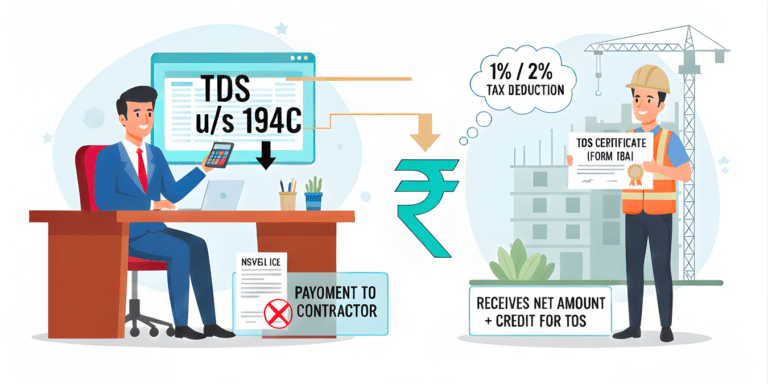
Get ready for a tax revolution! The Revised Income Tax Bill 2025, dropping August 11, promises simpler rules, bigger rebates, and surprises that could reshape your finances. This bill slashes TDS, boosts rebates to Rs. 60,000, and clarifies NRI tax provisions.
Waking up to a tax system that’s simpler, fairer, and surprisingly taxpayer-friendly—but with a twist that could reshape your financial future. As India stands on the cusp of a monumental fiscal overhaul, the Revised Income Tax Bill 2025 is set to debut on August 11, 2025, promising revelations that could either lighten your tax burden or throw unexpected curveballs. Withdrawn dramatically on August 8, 2025, amid whispers of errors and parliamentary pushback, this bill isn’t just another legislative update—it’s a potential game-changer for millions of Indians. What secrets does it hold? Will it slash rates, boost rebates, or hide surprises in its simplified clauses? Buckle up as we unravel the suspense, backed by the latest data from official sources and expert analyses, to uncover what’s really coming in the Revised Income Tax Bill 2025.
The Plot Thickens: Why Was the Original Bill Withdrawn?
In the ever-evolving landscape of Indian taxation, the Income Tax Bill 2025 has been a hot topic since its initial introduction on February 13, 2025, during the Union Budget 2025-26. Aimed at replacing the archaic Income Tax Act of 1961, this legislation was hailed as a revolutionary step toward simplification. Yet, in a shocking turn of events, Union Finance Minister Nirmala Sitharaman withdrew the original bill from the Lok Sabha on August 8, 2025, citing the need to incorporate recommendations from a 31-member Select Committee led by BJP MP Baijayant Panda. This move has sparked widespread curiosity: Why pull back a bill that promised to modernize India’s tax framework? And what’s brewing in the revised version set to drop on August 11?
The original bill was introduced to streamline the convoluted 1961 Act, which, with over 4,000 amendments and 500,000 words, has become a nightmare for taxpayers and professionals alike. The initial draft promised no major shifts in tax rates or residency rules but focused on linguistic simplicity: shorter provisions, fewer provisos, and consolidated sections. Tax experts estimated it could reduce compliance time by up to 30%, making it a beacon of hope for small businesses and salaried individuals.
But here’s where the suspense builds. Reports suggest “errors” in the draft—possibly ambiguities in capital gains taxation or drafting oversights—prompted the withdrawal. The government aimed to avoid confusion by integrating the Select Committee’s 285 recommendations, spanning over 4,500 pages, to ensure a polished, inclusive bill. This strategic pause has set the stage for a relaunch that’s got everyone talking. Was it a clerical mishap, or are deeper changes afoot? Let’s dive into what the revised bill might hold.
What’s New in the Revised Income Tax Bill 2025?
The Revised Income Tax Bill 2025 is poised to maintain its simplification ethos while introducing key amendments that could surprise taxpayers. Here’s a sneak peek at the most anticipated changes, based on leaks, official hints, and expert insights:
1. Tax Rebate Boost: A Middle-Class Game-Changer
One of the most curiosity-sparking updates is the hike in the tax rebate under Section 87A for those opting for the new tax regime. The rebate has jumped from Rs. 25,000 to Rs. 60,000, meaning individuals earning up to Rs. 12 lakh annually could effectively pay zero tax. This is a massive relief for middle-class families grappling with inflation, potentially saving them Rs. 15,000–20,000 annually. But here’s the twist: Will this rebate extend to the old regime, or is it a subtle nudge toward the default new regime introduced via the Finance Act 2024? The new regime, now mandatory for AY 2024-25 onward, offers lower rates but fewer deductions, creating a dilemma for deduction-heavy taxpayers.
2. TDS Reduction: A Surprise for the Insurance Sector
A standout change is the reduction in Tax Deducted at Source (TDS) on insurance commissions from 5% to 2%. This could inject liquidity into the insurance sector, benefiting agents and policyholders alike. Imagine earning more from commissions without hefty upfront deductions—a surprising relief for gig economy workers in finance! This move could also boost insurance penetration, which currently stands at 4.2% in India, per IRDAI data.
3. Anonymous Donations: A Charitable Twist
In a move that’s raised eyebrows, the bill exempts anonymous donations to purely religious trusts from taxation, aligning with efforts to boost philanthropy. NGO forecasts suggest this could increase donations by 15–20%, a boon for charitable sectors. However, donations to trusts with mixed functions (e.g., running hospitals or schools) will still be taxed, creating a nuanced distinction that’s sure to spark debate. Secular critics may see this as a surprise pivot, while religious organizations will likely applaud it.
4. Capital Gains Clarity: No LTCG Rate Hike
For those searching “income tax changes 2025 India,” the capital gains taxation updates are intriguing. Contrary to rumors of an 18.5% Long-Term Capital Gains (LTCG) rate, the revised bill retains the current 12.5% for most assets. However, it introduces Schedule-XIII, replacing the old Schedule 11, with streamlined exclusions for luxury goods. This could subtly affect high-net-worth individuals, making luxury imports slightly more taxable—a surprising nod to progressive taxation.
5. Salaried Employees: Enhanced Deductions?
Salaried taxpayers searching for “new income tax regime 2025” will be curious about potential enhancements to the standard deduction, rumored to rise from Rs. 50,000 to Rs. 75,000 (though unconfirmed). Another suspenseful possibility is higher tax-free limits for employer contributions to the National Pension System (NPS), encouraging retirement savings. These changes could make the new regime more attractive, but will they sway old-regime loyalists?
6. Simplified Compliance for Businesses
For businesses, the bill promises consolidated sections and digital tools for seamless e-filing, potentially cutting audit times by 25%. A leaked provision suggests decriminalizing minor delays in TDS payments, shifting from penalties to interest-only charges. This humane approach could attract small businesses, reducing the fear of prosecution. However, stricter scrutiny on crypto transactions might surprise digital asset holders, aligning with global norms.
7. NRI Taxation: Clarity for Global Indians
Non-Resident Indians (NRIs) will find relief in clarified overseas income taxation rules, reducing disputes with tax authorities. The bill retains current residency rules, ensuring no nasty surprises for global Indians. Effective from April 1, 2026, these changes could simplify NRI filings, potentially boosting remittances, which hit $112 billion in 2024, per RBI data.
The Suspense: Hidden Pitfalls or a Taxpayer’s Dream?
As August 11 approaches, the buzz around “finance bill 2025 India” is palpable. The revised bill, per sources, will be “simple and lucid,” with no substantive rate changes but profound structural reforms. Tax professionals predict a 25% drop in litigation due to clearer language, potentially saving billions in legal costs. The integration of AI-driven audits and Aadhaar-linked apps for instant rebates could make taxation intuitive—a futuristic leap for India’s 70 million taxpayers.
But suspense lingers. Will indexation benefits return for property sales? The original bill axed them, sparking protests from real estate groups, but committee suggestions might revive partial relief. Another question: Does the simplification mask increased surveillance? Critics warn of AI-driven audits potentially overstepping privacy, while optimists see a win for the common man.
The Bigger Picture: Economic Context
Zooming out, the Revised Income Tax Bill 2025 fits into India’s broader economic narrative. The Economic Survey 2025 projects GDP growth at 7% for 2025-26, with tax collections up 18% year-on-year, thanks to digital compliance. Simplified taxes could fuel investment, especially for MSMEs, which contribute 30% to GDP. The bill’s focus on small businesses—through simplified compliance and reduced litigation—could empower the 63 million MSMEs, per MSME Ministry data.
For those eyeing “tax rebate 2025,” the Rs. 60,000 rebate is a headline-grabber, but the real attraction lies in the bill’s potential to make taxation user-friendly. Imagine calculating taxes via an app, with instant rebates credited to your account—a dream for tech-savvy millennials. Yet, the suspense remains: Will the bill live up to its hype, or are there hidden clauses waiting to surprise us?
Why August 11 Matters
The unveiling of the Revised Income Tax Bill 2025 on August 11 isn’t just a legislative event; it’s a suspenseful saga of reform. From rebate boosts to simplified clauses, it promises surprises that could redefine your finances. Will it be a taxpayer’s dream or a mixed bag of reforms? Mark your calendars for August 11—stay tuned for live updates on “revised income tax bill 2025” as this could be the tax revolution India has awaited.
Key Takeaways
- Tax Rebate Hike: Up to Rs. 60,000 under Section 87A, potentially zero tax for incomes up to Rs. 12 lakh.
- TDS Relief: Insurance commissions now face 2% TDS, down from 5%.
- Charitable Boost: Anonymous donations to religious trusts tax-exempt.
- Capital Gains: LTCG stays at 12.5%, with streamlined luxury goods taxation.
- Business Ease: Simplified compliance and decriminalized TDS delays.
- NRI Clarity: Streamlined overseas income taxation from April 1, 2026.
- Suspense: Will indexation return? Are AI audits a privacy concern?
Stay Curious, Stay Informed
As India braces for this fiscal milestone, the Revised Income Tax Bill 2025 is more than legislation—it’s a narrative of change, suspense, and opportunity. Whether you’re a salaried employee, a small business owner, or an NRI, this bill could reshape your financial landscape. Join the conversation on social media with #IncomeTaxBill2025 and share your expectations. What surprises do you hope for on August 11? Let’s unravel the mystery together!
































